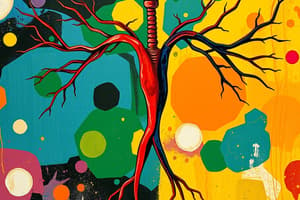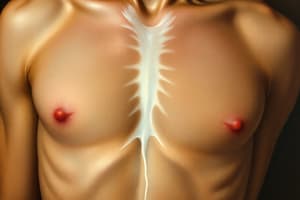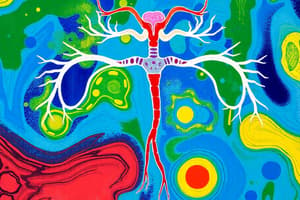Podcast
Questions and Answers
Which hormone primarily facilitates the storage of glucose as glycogen in the liver and skeletal muscle?
Which hormone primarily facilitates the storage of glucose as glycogen in the liver and skeletal muscle?
- Insulin (correct)
- Cortisol
- Glucagon
- Growth Hormone
What distinguishes gluconeogenesis from glycogenolysis?
What distinguishes gluconeogenesis from glycogenolysis?
- Gluconeogenesis breaks down glucose into pyruvate, while glycogenolysis synthesizes glycogen from glucose.
- Gluconeogenesis synthesizes glucose from non-carbohydrate sources, while glycogenolysis breaks down glycogen to release glucose. (correct)
- Gluconeogenesis synthesizes glycogen from glucose, while glycogenolysis breaks down glucose into pyruvate.
- Gluconeogenesis breaks down glycogen to release glucose, while glycogenolysis synthesizes glucose from non-carbohydrate sources.
Which of the following best describes the role of somatostatin (SST) in regulating carbohydrate metabolism?
Which of the following best describes the role of somatostatin (SST) in regulating carbohydrate metabolism?
- It inhibits both insulin and glucagon secretion. (correct)
- It enhances the effects of growth hormone on glucose production.
- It promotes the breakdown of glycogen in the liver.
- It directly stimulates glucose uptake in muscle cells.
How do Glucagon-like peptide-1 (GLP-1) and Gastric inhibitory polypeptide (GIP) primarily influence glucose metabolism?
How do Glucagon-like peptide-1 (GLP-1) and Gastric inhibitory polypeptide (GIP) primarily influence glucose metabolism?
In a prolonged fasting state, which hormonal change would be least expected?
In a prolonged fasting state, which hormonal change would be least expected?
How does growth hormone contribute to glucose homeostasis?
How does growth hormone contribute to glucose homeostasis?
Which of the following hormones primarily promotes lipogenesis?
Which of the following hormones primarily promotes lipogenesis?
How do adiponectin and resistin influence insulin sensitivity?
How do adiponectin and resistin influence insulin sensitivity?
Which of the following scenarios would MOST directly inhibit insulin secretion in pancreatic beta cells?
Which of the following scenarios would MOST directly inhibit insulin secretion in pancreatic beta cells?
A researcher is studying a novel drug that aims to improve glycemic control in type 2 diabetes. Which mechanism of action would MOST effectively mimic the effects of GLP-1?
A researcher is studying a novel drug that aims to improve glycemic control in type 2 diabetes. Which mechanism of action would MOST effectively mimic the effects of GLP-1?
A patient with a pancreatic tumor has excessive secretion of somatostatin. How would this DIRECTLY affect insulin secretion and blood glucose levels?
A patient with a pancreatic tumor has excessive secretion of somatostatin. How would this DIRECTLY affect insulin secretion and blood glucose levels?
A new drug is being developed to treat diabetes by enhancing insulin secretion. Which of the following mechanisms would present the GREATEST risk of causing hypoglycemia if not carefully regulated?
A new drug is being developed to treat diabetes by enhancing insulin secretion. Which of the following mechanisms would present the GREATEST risk of causing hypoglycemia if not carefully regulated?
In a clinical trial studying the effects of a novel drug on insulin secretion, researchers observe that the drug significantly enhances insulin release only in the presence of elevated glucose levels. Which mechanism of action is MOST likely responsible for this effect?
In a clinical trial studying the effects of a novel drug on insulin secretion, researchers observe that the drug significantly enhances insulin release only in the presence of elevated glucose levels. Which mechanism of action is MOST likely responsible for this effect?
What is the primary mechanism by which insulin facilitates glucose uptake in adipocytes?
What is the primary mechanism by which insulin facilitates glucose uptake in adipocytes?
How does insulin influence fatty acid metabolism in adipose tissue?
How does insulin influence fatty acid metabolism in adipose tissue?
What intracellular change directly enables the rapid effects of insulin on glucose and potassium transport?
What intracellular change directly enables the rapid effects of insulin on glucose and potassium transport?
Why is C-peptide measured in conjunction with insulin levels, and what does it indicate?
Why is C-peptide measured in conjunction with insulin levels, and what does it indicate?
In what way does insulin affect hepatic glucose metabolism, and how does this contribute to overall glucose homeostasis?
In what way does insulin affect hepatic glucose metabolism, and how does this contribute to overall glucose homeostasis?
What are the distinct roles of the mitogenic and transcriptional pathways activated by insulin, and how do they contribute to cellular function?
What are the distinct roles of the mitogenic and transcriptional pathways activated by insulin, and how do they contribute to cellular function?
How does insulin's effect on potassium uptake relate to its broader metabolic functions, and in what clinical context is this most relevant?
How does insulin's effect on potassium uptake relate to its broader metabolic functions, and in what clinical context is this most relevant?
What distinguishes the mechanism of insulin action in the liver compared to skeletal muscle and adipose tissue concerning glucose uptake?
What distinguishes the mechanism of insulin action in the liver compared to skeletal muscle and adipose tissue concerning glucose uptake?
How do amylin and insulin interact to regulate postprandial glucose levels, and what is the physiological significance of this interaction?
How do amylin and insulin interact to regulate postprandial glucose levels, and what is the physiological significance of this interaction?
What is the role of SNAT-2 transporters in skeletal muscle and how does insulin influence their function to affect amino acid metabolism?
What is the role of SNAT-2 transporters in skeletal muscle and how does insulin influence their function to affect amino acid metabolism?
Considering the extended timeframe of insulin action, what accounts for insulin's effect on lipogenic enzyme mRNA levels?
Considering the extended timeframe of insulin action, what accounts for insulin's effect on lipogenic enzyme mRNA levels?
How do catabolic hormones counteract insulin's effects to maintain glucose homeostasis during periods of stress or fasting?
How do catabolic hormones counteract insulin's effects to maintain glucose homeostasis during periods of stress or fasting?
How does insulin resistance impact the typical sequence of events following insulin binding to its receptor?
How does insulin resistance impact the typical sequence of events following insulin binding to its receptor?
What is the role of proteinase enzymes in insulin synthesis, and why is this processing step essential for insulin function?
What is the role of proteinase enzymes in insulin synthesis, and why is this processing step essential for insulin function?
Aside from glucose levels, what other factors stimulate insulin release from pancreatic beta cells and how significant are they?
Aside from glucose levels, what other factors stimulate insulin release from pancreatic beta cells and how significant are they?
Flashcards
Insulin Secretion
Insulin Secretion
Pancreatic beta cells release insulin in response to glucose.
GLUT-2 Role
GLUT-2 Role
GLUT-2 transports glucose into beta cells, where it's metabolized.
ATP's Insulin Link
ATP's Insulin Link
ATP inhibits potassium channels, leading to depolarization and calcium influx.
GIP & GLP-1
GIP & GLP-1
Signup and view all the flashcards
GLP-1 Benefits
GLP-1 Benefits
Signup and view all the flashcards
Glycogenesis
Glycogenesis
Signup and view all the flashcards
Glycogenolysis
Glycogenolysis
Signup and view all the flashcards
Glycolysis
Glycolysis
Signup and view all the flashcards
Gluconeogenesis
Gluconeogenesis
Signup and view all the flashcards
Adipogenesis
Adipogenesis
Signup and view all the flashcards
Lipogenesis
Lipogenesis
Signup and view all the flashcards
Lipolysis
Lipolysis
Signup and view all the flashcards
Insulin's Net Effect
Insulin's Net Effect
Signup and view all the flashcards
Hormones Increasing Glucose
Hormones Increasing Glucose
Signup and view all the flashcards
Anabolic Function
Anabolic Function
Signup and view all the flashcards
Catabolic Function
Catabolic Function
Signup and view all the flashcards
Insulin's Anabolic Role
Insulin's Anabolic Role
Signup and view all the flashcards
Glucagon's Catabolic Role
Glucagon's Catabolic Role
Signup and view all the flashcards
Pancreatic Islet Cells
Pancreatic Islet Cells
Signup and view all the flashcards
Glucagon Source
Glucagon Source
Signup and view all the flashcards
Insulin Source
Insulin Source
Signup and view all the flashcards
Proinsulin
Proinsulin
Signup and view all the flashcards
C-Peptide
C-Peptide
Signup and view all the flashcards
Stimulus for Insulin Release
Stimulus for Insulin Release
Signup and view all the flashcards
Insulin Action: GLUT4
Insulin Action: GLUT4
Signup and view all the flashcards
GLUT4 Transporter
GLUT4 Transporter
Signup and view all the flashcards
Stimuli for Insulin Release
Stimuli for Insulin Release
Signup and view all the flashcards
Insulin in Adipose Tissue
Insulin in Adipose Tissue
Signup and view all the flashcards
Study Notes
- Insulin, glucagon, somatostatin, epinephrine, growth hormone, and cortisol regulate metabolism.
- These hormones control glucose, protein, and fat metabolism.
- Gut hormones (GI hormones) and nutrients also play a role in controlling metabolism.
Definitions
- Glycogenesis: Glycogen formation.
- Glycogenolysis: Glycogen breakdown.
- Glycolysis: Glucose breakdown to pyruvate or lactate.
- Gluconeogenesis: Generation of glucose from non-carbohydrate substrates.
- Adipogenesis: Differentiation of pre-adipocytes into adipocytes.
- Lipogenesis: Conversion of acetyl-CoA to fatty acids.
- Lipolysis: Breakdown of fat and lipids to release fatty acids.
Hormones Regulating Carbohydrate and Lipid Metabolism
- Pancreas:
- Insulin: Promotes glucose and lipid storage; acts on the liver, fat, and skeletal muscle.
- Glucagon: Promotes glucose production; acts on the liver, fat, and skeletal muscle.
- Somatostatin (SST): Regulates insulin and glucagon (inhibits them); acts on multiple sites.
- Amylin: Inhibits glucagon; acts on multiple sites.
- Pituitary (Anterior):
- Growth Hormone: Promotes glucose production; acts on the liver.
- Adrenal Gland:
- Epinephrine, Cortisol: Increase glucose production; act on multiple sites.
- GI Tract:
- GLP-1, GIP, Gastrin, Secretin, CCK: Alter insulin secretion; act on the pancreas.
- Adipose Tissue:
- Leptin, Adiponectin, Resistin: Induce satiety, decrease glucose levels, and cause insulin resistance; act on the brain and other sites.
- Thyroid:
- T3, T4: Regulate metabolism and metabolic rate; act on all cells.
Key Acronyms
- GH: Growth Hormone
- GLP-1: Glucagon-like peptide-1
- GIP: Gastric inhibitory polypeptide
- CCK: Cholecystokinin
Hormones and Glucose Levels
- Cortisol, Growth Hormone, Glucagon, and Epinephrine increase plasma glucose levels.
Anabolic vs. Catabolic Functions
- Anabolic Functions
- Hormones: Insulin, Growth Hormone (protein synthesis only)
- Builds storage forms such as protein, fat, and glycogen from smaller molecules.
- Catabolic Functions
- Hormones: Glucagon, Epinephrine, Cortisol
- Breaks down larger molecules into smaller ones to increase glucose level for metabolic needs (ex: glycogen to glucose)
- Insulin promotes the synthesis of protein, triglycerides, and glycogen.
- Growth hormone has an anabolic feature specifically in protein synthesis.
- Glucagon breaks down glycogen into glucose.
- Epinephrine and Cortisol also have catabolic functions.
Pancreatic Islets and Insulin Synthesis
- Alpha cells produce glucagon.
- Beta cells produce insulin.
- Delta cells produce somatostatin.
- PP cells produce pancreatic polypeptides.
- Insulin is synthesized as proinsulin in the rough ER, transported to the Golgi, and stored in granules.
- Upon receiving a signal for release, granules fuse with the cell membrane and release insulin.
- Insulin is a hydrophilic hormone.
- Proinsulin is cleaved by proteinase enzyme into insulin and C-peptide chain.
- C-peptide has no biological activity, but is measured to indirectly assess insulin levels (1:1 ratio with insulin).
- Real insulin has two chains connected by disulfide bonds.
Insulin Release
- Insulin is released from granules in response to increased plasma glucose levels.
- Glucose concentration increase serves as the stimulating signal for insulin secretion.
- Insulin is not a steroid hormone, it is a peptide hormone that requires processing (proteinase cleavage).
- The major function of insulin is anabolic.
Mechanism of Action of Insulin
- Insulin activates PI3 kinase when it binds to receptors.
- PI3 kinase helps insert GLUT4 into the cell membrane.
- Allows glucose to enter the cell.
- Glycogen storage and protein synthesis are promoted (anabolic).
- Transcriptional pathway: regulates synthesis of mRNA and proteins, controlling various cellular functions.
- Mitogenic pathway: regulated by MAP kinase to regulate mitogenic effects like proliferation.
- Vesicles with GLUT4 fuse with the cell membrane due to PI3 kinase activation allowing for the glucose to enter.
Speed of Insulin Action
- Rapid (seconds)
- Transport of GLUT4 to the cell membrane
- Potassium uptake into the cell
- Intermediate (minutes)
- Stimulates protein synthesis
- Activates glycolytic enzymes (glucose to pyruvate)
- Activates glycogen synthase
- Slow (hours)
- Inhibits phosphorylase and gluconeogenic enzymes
- Increases mRNAs for lipogenic enzymes (fat metabolism)
Key Points
- Insulin decreases glucose concentration through various mechanisms.
- Insulin has a slow effect in synthesizing enzymes for fat synthesis and storage.
- Insulin receptors have binding sites on the cell surface and a kinase component in the cytoplasm.
- GLUT4 transporters are already synthesized inside the cell, needing only a signal for insertion.
- Insulin promotes protein synthesis, not degradation (anabolic).
Physiological Functions of Insulin in Different Organs
- Stimuli for Insulin Release: Glucose and amino acids.
- Liver:
- Stimulates glucose uptake (metabolized or stored as glycogen).
- Increases glycolysis, glycogen synthesis, lipid synthesis, protein synthesis
- Fat Tissue:
- Synthesizes triglycerides (storage format).
- Skeletal Muscle:
- Synthesizes protein from amino acids, increase glucose uptake, increase glycogen synthesis.
- Decreases protein catabolism, gluconeogenesis from amino acids, and increases ketone and potassium uptake.
- Amylin, secreted from beta cells, inhibits glucagon and decreases glucose concentration by slowing gastric emptying and increasing satiety.
Insulin Actions in Fat Tissue (Adipose Tissue)
- Insulin binds to cell surface receptors.
- Increases glucose entry via GLUT4.
- Increases glycerol phosphate synthesis.
- Activates lipoprotein lipase (LPL).
- LPL breaks down fat complexes in blood vessels, releasing fat for use by fat cells (adipocytes).
- Increases long-chain fatty acid entry via FATP transporter.
- Increases fatty acid synthesis and triglyceride deposition.
- Inhibits hormone-sensitive lipase (HSL).
- HSL breaks down triglycerides into free fatty acids and glycerol.
- Increases potassium uptake into cells.
Insulin Actions in Skeletal Muscle
- Insulin binds to receptors.
- Increases amino acid uptake via SNAT-2 transporter for protein synthesis.
- Increases glucose uptake via GLUT-4.
- Increases glycogen synthesis.
- Decreases protein catabolism.
- Decreases release of gluconeogenic amino acids.
- Increases ketone uptake.
- Increases potassium uptake into the cells.
Insulin Actions in the Liver
- Glucose uptake is not insulin-dependent, it depends on the concentration gradient.
- Insulin increases glycolysis, decreasing intracellular glucose, creating a gradient for uptake.
- Increases glycogen synthesis.
- Decreases gluconeogenesis.
- Decreases ketogenesis (prevents ketoacidosis).
- Increases protein and lipid synthesis (anabolic features).
Glucose Stimulated Insulin Secretion in Beta Cells
- Beta cells in pancreatic islets secrete insulin.
- Glucose uptake via GLUT-2 in beta cells.
- Glucose is phosphorylated and metabolized to pyruvate.
- Pyruvate is oxidized in mitochondria, producing ATP.
- ATP inhibits potassium channels, leading to cell depolarization.
- Depolarization activates calcium channels, causing calcium influx.
- Calcium influx stimulates insulin granule fusion with cell membrane and insulin release.
Factors Affecting Insulin Secretion
- Stimulators:
- Glucose, amino acids, beta-keto acids, glucagon, acetylcholine
- Intestinal hormones (GIP, GLP, secretin, CCK)
- Beta-adrenergic stimulators (theophylline)
- Sulfonylurea drugs
- Inhibitors:
- Low potassium concentration
- Somatostatin, galanin
- Adrenal stimulators (epinephrine, norepinephrine)
- Propranolol, diazoxide, thiazide diuretics
GI Hormones that Stimulate Insulin
- GIP (Gastric Inhibitory Peptide/Glucose-dependent insulinotropic peptide):
- Produced by intestinal K cells in the duodenum and jejunum.
- Released in response to fat and glucose (fat more inhibitory).
- Stimulates insulin secretion in the presence of glucose.
- Enhances fatty acid incorporation into triglycerides, stimulates LPL.
- Promotes beta cell proliferation and survival.
- GLP-1 (Glucagon-like peptide-1):
- Secreted by intestinal L cells in the small bowel and colon.
- Released in response to amino acids, fiber, sweeteners, sugars, glucose, and fatty acids.
- Stimulates insulin secretion in the presence of glucose, reduces hypoglycemia.
- Inhibits gastric emptying, decreases food intake.
- Inhibits glucagon secretion, slows glucose production.
- Protects beta cells from apoptosis and stimulates beta cell proliferation, maintaining beta cell mass.
Studying That Suits You
Use AI to generate personalized quizzes and flashcards to suit your learning preferences.




